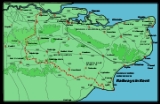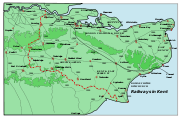
Fawkham Junction
Encyclopedia

Rail transport
Rail transport is a means of conveyance of passengers and goods by way of wheeled vehicles running on rail tracks. In contrast to road transport, where vehicles merely run on a prepared surface, rail vehicles are also directionally guided by the tracks they run on...
junction
Junction (rail)
A junction, in the context of rail transport, is a place at which two or more rail routes converge or diverge.This implies a physical connection between the tracks of the two routes , 'points' and signalling.one or two tracks each meet at a junction, a fairly simple layout of tracks suffices to...
that currently connects High Speed 1 with the Kent Rail Network
Chatham Main Line
The Chatham Main Line is a British railway line that runs from either London Victoria to Dover Priory / Ramsgate or London St Pancras to Faversham, with both services travelling via Medway...
.
Originally the Junction was part of the London, Chatham and Dover Railway
London, Chatham and Dover Railway
The London, Chatham and Dover Railway was a railway company in south-eastern England from 1859 until the 1923 grouping which united it with other companies to form the Southern Railway. Its lines ran through London and northern and eastern Kent to form a significant part of the Greater London...
's line to Gravesend West
Gravesend West Line
The Gravesend West Line was a short railway line in Kent that branched off the Swanley to Chatham line at Fawkham Junction and continued for a distance of 5 miles to Gravesend where the railway company constructed a pier to connect trains with steamers...
(Gravesend which was already served by the South Eastern Railway
South Eastern Railway (UK)
The South Eastern Railway was a railway company in south-eastern England from 1836 until 1922. The company was formed to construct a route from London to Dover. Branch lines were later opened to Tunbridge Wells, Hastings, Canterbury and other places in Kent...
's North Kent Line
North Kent Line
The North Kent Line is a railway line which connects central and south east London with Dartford and Medway.-Construction:The North Kent Line was the means by which the South Eastern Railway were able to connect its system to London at London Bridge...
). The intermediate stations were: Longfield Halt
Longfield Halt railway station
Longfield Halt was a railway station on the Gravesend West Line which served the settlement of Grubb Street in Kent, England.- History :...
, Southfleet
Southfleet railway station
Southfleet was a railway station on the Gravesend West Line which served the small village of Southfleet in Kent, England.- Opening :...
, Rosherville Halt
Rosherville Halt railway station
Rosherville Halt was a railway station on the Gravesend West Line which was built to serve the popular Rosherville Gardens, a pleasure garden in Gravesend, Kent which closed in 1910...
and Gravesend West
Gravesend West railway station
Gravesend West was a railway station on the Gravesend West Line which served Gravesend in Kent. It opened in 1886 and was, for some time, a regular destination for boat trains from London which linked with steamers on the station's pier to ferry passengers to a variety of coastal towns and resorts....
. With the amalgamation of the two competing rail companies into the South Eastern and Chatham Railway
South Eastern and Chatham Railway
The South Eastern and Chatham Railway Companies Joint Management Committee , known by its shorter name of the South Eastern and Chatham Railway was a working union of two neighbouring rival railways, the South Eastern Railway and London, Chatham and Dover Railway , that operated services between...
in 1899, the line's future was doomed. Passenger services were curtailed and the line was not electrified
Railway electrification in Great Britain
Railway electrification in Great Britain started towards of the 19th century. A great range of voltages have been used in the intervening period using both overhead lines and third rails, however the most common standard for mainline services is now 25 kV AC using overhead lines and the...
, it eventually closed to passengers in 1953 and freight services eventually ceased in 1976. Preservation attempts failed.
The Channel Tunnel Rail Link
Channel Tunnel Rail Link
High Speed 1 , officially known as the Channel Tunnel Rail Link and originally as the Continental Main Line , is a high-speed railway line running from London through Kent to the British end of the Channel Tunnel.The line was built to carry international passenger traffic from the United Kingdom...
(CTRL) gave part of the line a new lease of life with the rebuilding of the rural section near Southfleet
Southfleet
Southfleet is a small compact village five miles SW of Gravesend in Kent; it is a civil parish within the borough of Dartford, and includes within its boundaries the hamlet of Betsham, and the even smaller settlement of Northfleet Green. The main village is grouped around a crossroads and many of...
as a spur linking the CTRL and the Chatham Main Line
Chatham Main Line
The Chatham Main Line is a British railway line that runs from either London Victoria to Dover Priory / Ramsgate or London St Pancras to Faversham, with both services travelling via Medway...
. Much of the original route was followed but the initial Fawkham Junction was repositioned slightly to allow for higher speeds. Several bridges were also rebuilt alongside or in place of their originals. No stations were reopened. The CTRL was built in two stages and the initial stage (phase 1) was connected to the rail network via this rebuilt line. The completion of phase 2 means this section is no longer used by Eurostar
Eurostar
Eurostar is a high-speed railway service connecting London with Paris and Brussels. All its trains traverse the Channel Tunnel between England and France, owned and operated separately by Eurotunnel....
trains. It only receives light use from engineering, non commercial trains and driver training purposes.
The line is the changeover between the third rail (750V DC) and overhead (25kV AC) systems of electrification
Railway electrification in Great Britain
Railway electrification in Great Britain started towards of the 19th century. A great range of voltages have been used in the intervening period using both overhead lines and third rails, however the most common standard for mainline services is now 25 kV AC using overhead lines and the...
.

